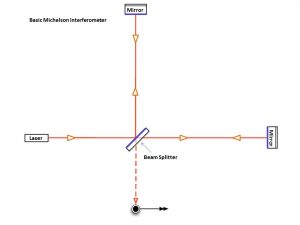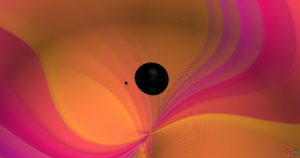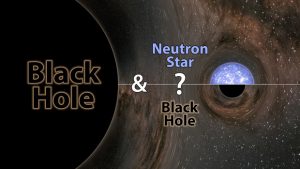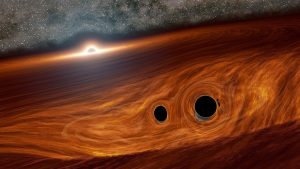Media
Transcript
Today’s news is less than straight forward, and we’re only going to cover two of the many news stories coming out because we want to get this right. Don’t worry. The stories we aren’t covering are just being shifted to tomorrow. For today, both stories are related to the detection of gravitational wave events and are believed to be caused by the merger of massive objects far off in the universe.
When we observe the universe, we can perceive events in three different ways: 1) we observe any light they may produce by seeing starlight with our eyes and the light from cold gas with radio telescopes; 2) we can potentially detect any particles they send our way, like neutrinos, and 3) we also look for the way gravitational pulls change the shape of space. This final way we see the universe generally means we look at how the paths of light and the motions of objects change near high-mass objects, but sometimes, we can actually detect waves of gravity propagating through the universe in the form of gravitational waves.
A large mass object, hanging out alone in the universe, deforms the space around it, but that is about it. Put that large mass into orbit with another large mass, and as they move, they are creating moving deformities in space-time, generating waves that carry energy away from the system. This was all predicted by Einstein in 1916, and we’ve known they exist since the 1970s when we could see how the energy gravitational waves carried away was changing the orbits of binary pulsars. This confirmation via indirect detection spurred on dreams of directly detecting gravitational waves from the distortions they create in space-time.
We’re not talking about figurative distortions; we’re talking literal, where things get stretched and compressed as these waves ripple through space.
One of the most accurate means we have for measuring changes in distance is light. The wavelengths of light can be smaller than the size of an atom, and light can only interfere when waves combine in integer and half-integer combinations that cause the lightwaves to either amplify or cancel one another out. The patterns of waves going through slits and then interfering with one another can easily be measured, and you can even generate a simple interference pattern by bouncing laser light off the surface of a CD and seeing a series of red dots on a wall, marking where the light combines in positive ways.

With gravitational wave detectors, laser beams are shined over great distances down tunnels that are at right angles to each other and combined in ways that allow the slightest change in length of those tunnels to be detected. By scattering multiple detectors around the world, it becomes possible to measure the effects of waves as they propagate through our planet, deforming everything as they travel at the speed of light. By looking to see when different detectors were deformed, we can follow the path of the wave and then work backward to localize its origin, very roughly, in the sky. In one very dramatic case, GW20170817, the merger of two neutron stars was detected not just in gravitational waves but also in particles and light as it went off during the merger.
Gravitational-wave detections are starting to become rather standard, with new events being captured on a regular basis and those detections being announced in real-time to allow more and more people to try to get follow-up observations of anything that may be associated with the events releasing the waves. This means that these events generally aren’t news.
Accept for today, apparently.
So far, the majority of published results have been of objects with fairly similar masses and have been in fairly boring situations.
The similar masses are just a fluke of how star systems form. In general, stars in binary systems aren’t too different in mass, and it is only when you start to get into triple systems that you see things forming in very different sizes. There are exceptions — there are always exceptions — but we expect things to not be too radically different on the high mass side of things. In high-density environments, however, you can end up with binary systems forming late in the stars’ lives as the objects interact in their orbits.

In April of 2019, a binary star system of extremely unequal mass was detected merging in a galaxy some 800 million light-years away. The more massive object was a fairly common 23 solar-mass black hole, but the smaller object was estimated to be about 2.6 solar masses, and no one is completely sure if it is a neutron star or a black hole. So far, the smallest black holes we’ve found are around 5 solar masses, and the largest neutron stars we’ve found are no more than 2.5 solar masses. That 2.6 solar-mass object should be a black hole, but we’re just not quite sure.
Neutron stars are, to first order, supported from collapse under their own gravity by the pressure of the neutron degenerate gas the star is made of. The particles are literally pushing each other apart just enough to hold the star up. Neutron stars can’t support unlimited force, however, and at a certain point, the neutron’s pressure will get overwhelmed and the object will collapse into a black hole, and we can’t even speculate at what goes on inside a black hole. The point at which neutron degenerate pressure can no longer support a star occurs somewhere around 2.5 solar masses, but secondary effects like spin and irregularities in composition and other stuff can all affect that limit.

It’s possible a 2.6 solar-mass object is a neutron star but probably not. So this could be the smallest black hole ever detected, and it was detected in the moment of its death. If we can get black holes this small, the question becomes, why haven’t we seen them this small before? The answer may be as simple as it is harder to find small black holes, or they are really rare, or both. Whatever this object is, it is gone, merged into that 23 solar-mass object to form a new and greater black hole than was there before.
Most black hole mergers occur in darkness. Literally, the events don’t emit any light.
At least not generally. Several years ago, theorists predicted that if a black hole merger occurred in the heart of a galaxy, the merger of the two black holes, under the gravitational influence of a supermassive black hole, could cause the resulting merged black hole to fly out of the heart of the galaxy and into the surrounding material. This rapid exit could cause the material being plowed through to light up. And now an example of this kind of a black hole making things light up seems to have been found.

In May of 2019, a gravitational wave detection was made in the direction of the quasar 1249+3449. I haven’t been able to find the ratio of the masses that merged, but the resulting new black hole is one hundred solar masses. Several days after the merger was detected, the Zwicky Transient Facility detected a flare-up that didn’t match a black hole. In a new paper in Physical Review Letters, a team lead by Matthew Graham describes how this one-two punch of observations matched the earlier predictions.
This is all described beautifully by co-author K. E. Saavik Ford of the City University of New York, who explains: At the center of most galaxies lurks a supermassive black hole. It’s surrounded by a swarm of stars and dead stars, including black holes. These objects swarm like angry bees around the monstrous queen bee at the center. They can briefly find gravitational partners and pair up but usually lose their partners quickly to the mad dance. But in a supermassive black hole’s disk, the flowing gas converts the mosh pit of the swarm to a classical minuet, organizing the black holes so they can pair up.
A gravitational wave showed us the pair up, and then optical telescopes showed us the pair on the run.
So the theorists got it right, and now we know we need to be wary of runaway black holes because really, they are a thing.
There is a lot more to this story, and we’re going to be inviting the team scientists to come on for an interview. Stay tuned! More on this story will be coming.
Learn More
LIGO-Virgo Finds Mystery Object in “Mass Gap”
- LIGO news release
- Northwestern Now press release (Northwestern University)
- Albert Einstein Institute Hannover press release (Max Plank Institute)
- University of Birmingham (UK) press release
- University of Portsmouth article
- Science and Technology Facilities Council news release (UKRI)
- “GW190814: Gravitational Waves from the Coalescence of a 23 Solar Mass Black Hole with a 2.6 Solar Mass Compact Object,” R. Abbott et al., 2020 June 23, Astrophysical Journal Letters
Black Hole Collision May Have Exploded with Light
- Caltech news release
- “A Candidate Electromagnetic Counterpart to the Binary Black Hole Merger Gravitational Wave Event GW190521g,” Matthew Graham et al., 2020 June 25, Physical Review Letters
Credits
Written by Pamela Gay
Hosted by Pamela Gay
Audio and Video Editing by Ally Pelphrey
Content Editing by Beth Johnson
Intro and Outro music by Kevin MacLeod, https://incompetech.com/music/


 We record most shows live, on Twitch. Follow us today to get alerts when we go live.
We record most shows live, on Twitch. Follow us today to get alerts when we go live.